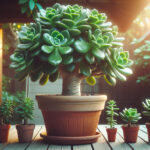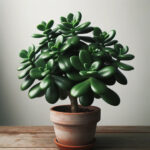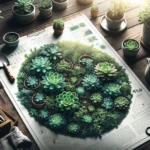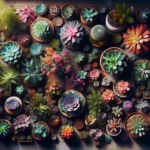Introduction to the Jade Plant and Crassula
Embark on a botanical journey as we untangle the verdant web that links the Crassula species with its widely renowned doppelgänger, the Jade Plant. These two have often been lumped together in horticultural hearsay, but today we’ll leaf through their stories to understand the roots of this confusion. Often mistaken siblings in the vast family of succulents, these plants illuminate why precise identification sparkles in the eyes of enthusiasts and experts alike.
Imagine strolling through a bustling city street, where amidst a concrete jungle, a pop of green catches your eye. It’s the sturdy, glossy leaves of a Jade Plant, lovingly perched in a cafe window, symbolizing prosperity and friendship. Now picture its botanical twin, the Crassula, a diverse genus with overtones of rugged beauty that lend it a distinct charisma among plant collectors. A  parallels this urban encounter, navigating our understanding of the ubiquity and allure of these succulent spectacles.
parallels this urban encounter, navigating our understanding of the ubiquity and allure of these succulent spectacles.
Within the scholarly circles of botany, the Crassula genus is a maze of over 200 species, each mapping to unique terrains and ecological whims. This succulent sorcery captivates hearts and sparks conversations about morphology, taxonomy, and the subtle art of differentiation. But what really stirs the pot is the popular Jade Plant, often a single species casually referred to as Crassula ovata. Its widespread cultivation and ease of care make it a poster child for indoor greenery, warranting a spotlight on these amazing plants. For more insights into nurturing these dessicated darlings, take a glimpse into successful succulent care.
As we peel away the layers, it becomes clear that Crassula and the Jade Plant share more than a passing resemblance; they reflect humanity’s desire to surround itself with life and vitality. Whether you’re a seasoned green thumb or just embarking on your horticultural adventure, recognizing the divergent paths these plants trace in the soil of our understanding emphasizes the joy in cultivating a greener world.
The Botanical Breakdown of Crassula Ovata
Let’s delve right in and examine the Crassula ovata, a plant that might be more familiar to you as the classic Jade Plant. This gem from the Crassula genus has enthralled plant enthusiasts all over the globe. But what makes it such a sweetheart in the succulent world? Well, it’s all in the details – the fleshy, glossy leaves that beg to be touched, and the robust stems that stand the test of time, much like a steadfast friend in the plant kingdom.
Crassula ovata belongs to the extensive Crassula genus, encompassing a diverse range of succulent species. This particular succulent is celebrated for its ease of care and the lush, green canopy it forms, which has earned it the endearing nicknames of Money Plant and Lucky Plant in different cultures. If you’re intrigued and want to nurture one yourself, here’s a comprehensive guide that will walk you through the ins and outs of caring for this hardy plant.
What’s truly captivating about Crassula ovata is its power to adapt and thrive in various environments, with minimal fuss. Its thick, jade-colored leaves have adapted to store water, allowing it to survive in arid climates. This technique is not just a survival trick; it’s a feature that adds to its appeal as a houseplant, especially for those who appreciate beauty with minimal maintenance.
In real life, the Crassula ovata isn’t just surviving; it’s thriving in homes, offices, and gardens, enriching spaces with its vibrant presence. For example, imagine a sunny kitchen windowsill where a potted Crassula ovata basks in the sun’s embrace, its succulent leaves glistening as they soak in the warmth. Interested in more tips on indoor plant placement? Check out this useful resource for arranging your indoor succulents.
So, is the Crassula ovata the same as the Jade Plant? Yes, indeed. It’s the botanical name for the beloved Jade Plant, and recognizing its scientific credentials only deepens our appreciation for this living decor staple. The next time you glimpse its green glory, remember you’re looking at an example of botanical brilliance – the Crassula ovata.
Identifying the Classic Jade Plant
Picture this: You’re meandering through an enchanting garden, and your gaze lands on a lustrous green succulent basking in the sunlight – it’s the classic Jade Plant. Its thick, glossy leaves mirror jade stones, signifying prosperity and good fortune in many cultures. But is this gem of a plant actually a Crassula? Let’s get to the root of it.

To spot a true Jade Plant, Crassula ovata, amidst the plethora of greenery, it’s essential to hone in on a few character traits. For starters, its signature paddle-shaped leaves are a dead giveaway. These fleshy emerald leaves often develop reddish tinges on their edges when exposed to just the right amount of sunshine, much like a sun-kissed glow. It’s also a powerhouse in water storage, allowing it to thrive even when the watering can is forgotten for a time.
Its thick, woody stems can sometimes fool an uninformed onlooker into thinking it’s a miniature tree. Over time, these plants grow with a dignified poise that can match the elegance of any room they adorn. If you’re curious about nurturing your own Jade Plant at home, check out this care guide for some green-thumbed inspiration.
Delving into the Crassula genus, we find more than just the classic Jade Plant. In fact, there’s a whole tapestry of varieties out there, each with its own distinct appeal. To explore this succulent saga further, why not take a peek at the succulent treasures aplenty in the Crassula family?
So, while the Jade Plant is indeed a shining star within the Crassula species, it’s not alone. It shares the spotlight with many other varieties, each contributing its own verse to the Crassula ode. Now that you know what to look for, the next time you encounter these succulent beauties, you’ll be able to identify the classic Jade Plant with confidence, appreciating its unique place in the botanical world.
Comparing Crassula and Jade Plant
When it comes to houseplants, few are as beloved and well-recognized as the sturdy Crassula and the resilient Jade Plant. The terms are often tossed around synonymously, but are they truly one and the same? Let’s take a closer look and peel back the layers of these succulent icons to demystify the confusion.
Visual Varieties: Spotting the Differences
Crassula is a large genus of succulent plants that brings a myriad of shapes, sizes, and textures to the table. From the ruffled leaves of Crassula ‘Buddha’s Temple’ to the paddle-shaped foliage of Crassula ovata, there’s a staggering range of visual diversity within this group. On the flip side, when people speak of the Jade Plant, they’re usually referring to the familiar Crassula ovata species, with its glossy green leaves tinged with red edges. This beloved species is often mistaken as the poster child for the entire Crassula genus, yet it is only one of many stars in the Crassula constellation.
The Subtle Art of Care: A Gardener’s Guide
Caring for these green companions may have some overlap, but each type has its particular needs that beg attention. Moisture vigilance is key; Crassula varieties often have varied water requirements, some preferring drier conditions than others. The Jade Plant—particularly Crassula ovata—is more forgiving, famous for its drought tolerance and ability to bounce back from a forgetful waterer’s neglect. Both plants prefer a sunny spot, but some Crassula species might demand more shade to prevent sun scorch than your typical Jade Plant.
Let’s not forget the role of the potting mix. These plants crave a well-draining home, and many garden enthusiasts swear by adding some sand or perlite into the mix for that extra drainage. In the realms of feeding, a common balanced, water-soluble fertilizer does the trick, applied sparingly to avoid overindulgence.
Horticultural Heroes: Common Usage in Our Lives
In the world of horticulture, Crassula, and specifically the Jade Plant, wear many hats. From the solitary elegance of a bonsai to the clustered charm of a dish garden, these plants adapt to various decorative roles. They’re often employed as symbols of prosperity and good fortune, making them popular gifts and office plants. Whether it’s the intricate layering of a Crassula ‘Hummel’s Sunset’ or the stout branches of a Jade Plant, they each inject a distinct personality into their surroundings.
Take a stroll through a botanical garden or browse an enthusiast’s plant collection, and you’ll witness the versatility of Crassula and Jade Plants. They stand proudly on sun-drenched windowsills and add a burst of green to shaded office corners all over the world. The seamless way they integrate into daily life is a testament to their universal appeal and underscores the importance of recognizing their distinct identities.
Incorporate an informative video into your learning journey to see these diverse cousins in action:
Importance of Proper Identification
Ever had that moment of confusion at a plant nursery when you see a succulent, and you think, “Is that a Crassula or a Jade Plant?” You’re not alone! Understanding the distinction between these green gems is more than just a matter of nomenclature; it’s essential for their thriving. Let’s delve into why it’s so important to differentiate between the Crassula and Jade Plant, especially when it comes down to care, propagation, and avoiding some all-too-common horticultural blunders.
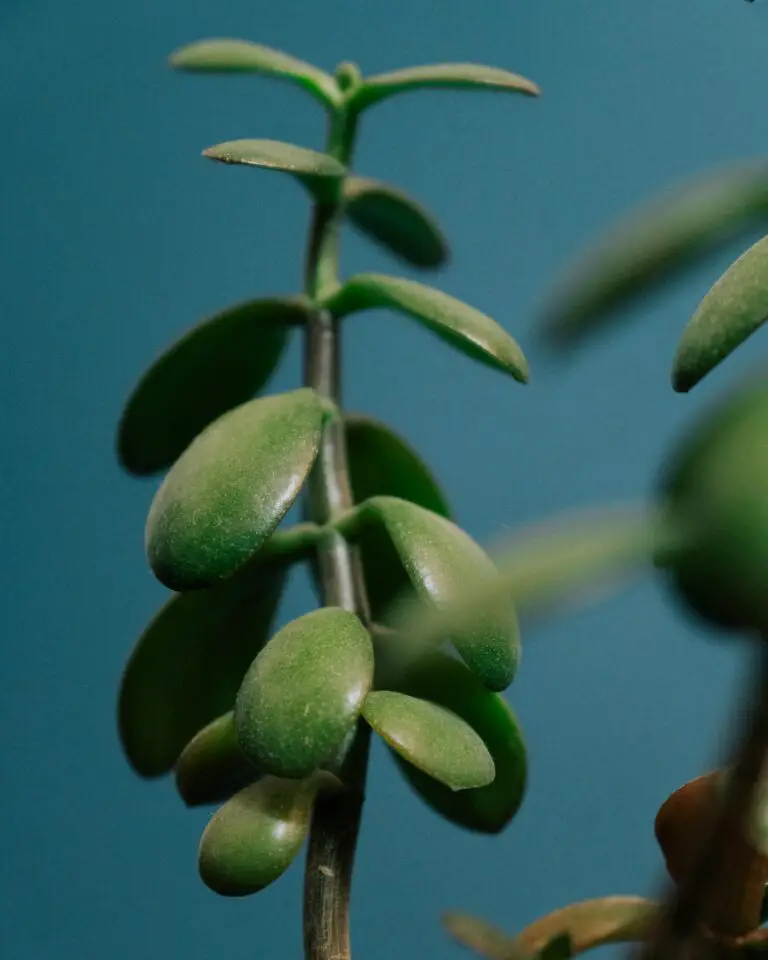
Imagine inviting a friend who prefers a diet of salads over steak and accidentally serving them a meaty meal—they wouldn’t be too happy, right? The same goes for our leafy friends. While they may look similar with their succulent leaves and sturdy stems, Crassula and Jade Plants have different appetites when it comes to light, water, and nutrition. Misidentification could lead you to overwater a Crassula or deprive a Jade Plant of its requisite sunshine—either mistake could spell disaster for these green buddies.
Propagation pratfalls can also arise from mistaken identities. Trying to propagate a leaf from a Crassula as you would a Jade Plant may leave you wondering why your new plant babies aren’t sprouting. Both might propagate with leaves or cuttings, but each has its unique protocol to follow. It’s like giving a cactus a waterlogged pot; no matter how much you hope, it’s never going to flourish without the right approach.
And let’s not forget about those pesky pests and peculiar pathogens. Different plants attract different foes. A mislabeled plant might be battling an ailment that seems unshakable, simply because you’re combating the wrong enemy. Proper identification empowers you with the right knowledge to defend your greenery effectively.
Ensuring you understand the nuanced differences between Crassula and Jade Plant helps in nurturing them to their best and most beautiful selves. Each requires its own special brand of TLC. So, the next time you’re admiring these succulents, remember, calling them by their proper name is the first step towards a flourishing friendship with your foliage.
Caring for Your Succulent: Tips and Best Practices
When it comes to nurturing your Crassula and Jade Plants, consider yourself more than just a plant owner—you’re a succulent guardian! Let’s dive into the succulent-care symphony, where each note represents a crucial element like light, watering, soil, and tackling common issues. Here’s how to orchestrate the perfect environment for your green companions.
Light: Illuminating Your Plants’ World
Imagine your succulent as a sunbather; both Crassula and Jade Plants relish bright, indirect sunlight. They thrive when soaking in gentle morning rays or basking in the soft glow of late afternoon light. Avoid harsh midday sun that could cast a scorching spell over your verdant friends—think of it as the villain in their fairytale!
Watering: Quenching Thirst the Right Way
Water is life, but overindulgence can be lethal for succulents. To water wisely, follow the “soak and dry” technique. Drench the soil until water runs out of the drainage holes, then wait until the soil is thoroughly dry before watering again. Picture your succulents doing a rain dance every few weeks, rejoicing in a deluge of hydration followed by a peaceful drought.
Soil: The Foundation of Succulent Health
Set the stage for success with well-draining soil. You want a mix that holds moisture long enough for the roots to take a sip but drains quickly to prevent a soggy mess. Think of the perfect potting mix as a fluffy duvet for your plant’s roots—cozy yet breathable, preventing any root-rot nightmares.
Here’s a snapshot of a Crassula plant thriving in its well-maintained habitat, reminding us that with the right care, these succulents can be not just alive, but vivaciously so:
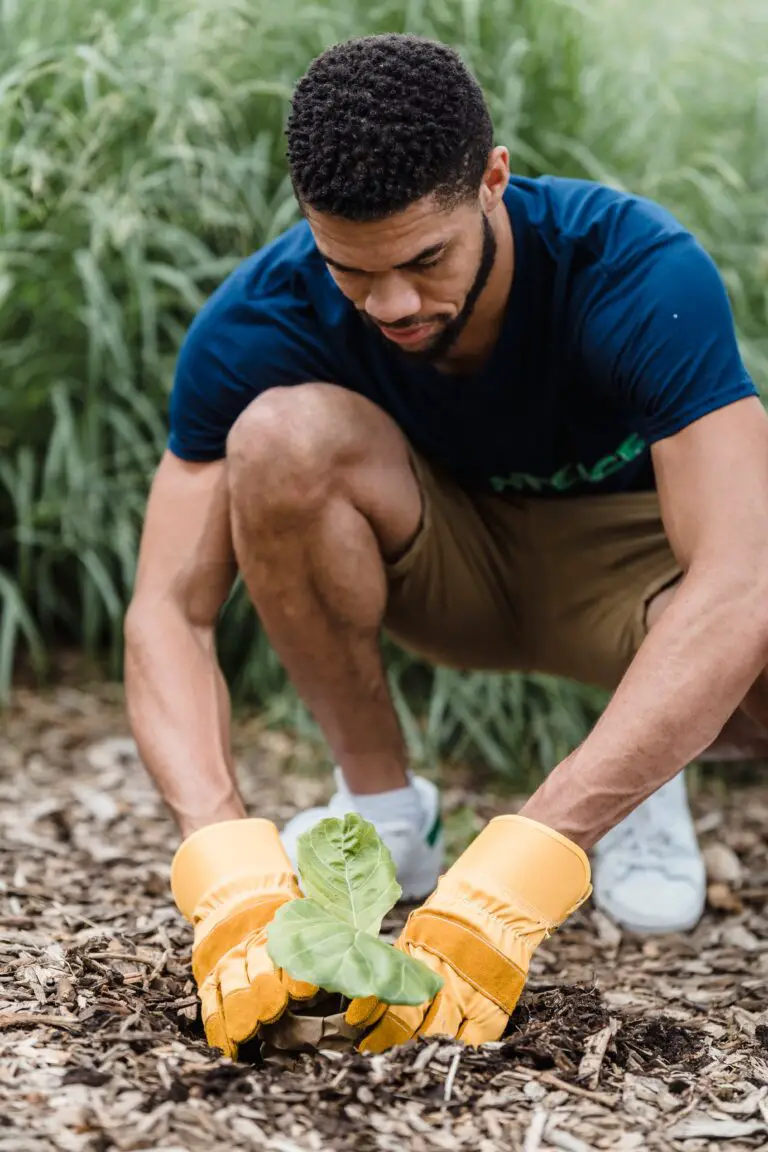
Common Issues: Become a Succulent Sleuth
Get to the root of problems by channeling your inner detective. Spotted leaves? It might be too much sunlight. Mushy, discolored stems? Overwatering could be the culprit. By keenly observing your plants’ responses to their care regimen, you’ll be well-equipped to solve any succulent mystery tossed your way.
Now, armed with these green-thumb guidelines, you’re ready to elevate your status from a casual succulent admirer to a bona fide succulent whisperer. Your Crassula and Jade Plants will thank you by flaunting their luscious leaves and robust health, becoming the living testament to your nurturing prowess.
The Cultural Significance and Symbolism
Delving into traditions far and wide, the Jade Plant emerges not just as a botanical wonder but as a vessel carrying rich cultural weight. One might wonder, what imbues this succulent with such veneration that it earns titles like ‘Money Plant’ and ‘Lucky Plant’? Let’s unearth the roots of this adulation that span continents and belief systems.
The Jade Plant, also scientifically known as Crassula ovata, has a storied reputation in Feng Shui, the ancient Chinese art of arranging living spaces. In this tradition, it’s believed that the Jade Plant’s lush, round leaves symbolize prosperity and renewal—a living, breathing token of good luck designed by nature itself. Many business owners, especially in East Asian cultures, position these plants near cash registers or in office spaces, hoping to attract financial success and positive energies.
Beyond the spheres of commerce, the Jade Plant holds personal significance for people looking for a stroke of good fortune in their homes. It’s a popular housewarming gift, an emblem of well-wishing for the home’s new chapter. Imagine a friend bringing over a potted Jade as a gesture of goodwill, ingrained with the belief that this simple succulent could foster abundance and goodwill within the domestic realm.
Further intertwining with life’s milestones, the presence of a Jade Plant is often seen at weddings, symbolizing the wish for a prosperous and enduring marriage. Picture a gift bestowed upon the newlywed couple: a green guardian to nurture as their relationship grows, its resilient nature standing testament to what love can weather and flourish through.
But it’s not just about wealth and good luck. The serenity exuded by its lush, jade-toned leaves has a calming influence, making it a staple in homes and offices seeking a slice of tranquillity amidst chaos. The psychological comfort it provides, akin to a beacon of stability and growth, amplifies its symbolic allure.
The fascination with the Jade Plant isn’t constricted by boundaries; it spills over into other cultures too. Across the oceans, in Western traditions where gardening is a meditative and reflective practice, the Jade Plant is celebrated for its resilience and low maintenance. It’s a testament to the bond between humans and flora—where caring for a plant becomes a metaphor for nurturing oneself and one’s own spiritual growth.
In this hue of green, we find more than a plant—we find narratives of hope, continuity, and abundance interlaced with human experiences, making the Crassula a beacon of positive symbolism across cultural landscapes. Isn’t it remarkable how a simple houseplant can hold such a vast cosmos of meanings, each leaf an anthology of human belief and sentiment?
Is Crassula the Same as Jade Plant? Unearth the Truth
Propagating Crassula and Jade Plants
Embarking on the journey of propagating Crassula and Jade Plants can be thrilling for any gardening enthusiast. Let’s roll up our sleeves and dive into the world where tiny succulent leaves give birth to luscious, plump plants. Propagation of these green gems is surprisingly straightforward and can lead to an ever-expanding collection of these robust succulents. Whether you’re a seasoned green thumb or a curious newcomer, understanding the process is key to a bountiful propagation.
Starting with the Crassula, often referred to as the ‘Hobbit’s’ garden favorite, the propagation process is almost magical. You can take a healthy leaf, lay it atop well-draining soil, and with the right mixture of sunlight and patience, watch as tiny roots seek out nourishment, gripping the soil tightly. Gradually, a miniature version of the mature plant forms at the base of the leaf, signaling the beginning of a new life cycle. Remember to keep the soil slightly moist but not waterlogged, as these succulents detest soggy feet.
Transitioning to the Jade Plant, known for its dense, tree-like structure and vibrant green leaves, the propagation methods are equally fascinating. With a mother plant in hand, snip a healthy stem, strip its lower leaves, and allow the cut end to callous over for a day or two. This bit of preparation is vital to prevent rot when you plant the stem into a container of well-draining succulent mix. In a few weeks, with proper care, those sturdy stems will anchor into their new home and sprout fresh growth. It’s essential to offer these baby Jades a soft morning sun and shield them from the harsh afternoon rays until they’re well established.
With such a straightforward propagation process, there’s plenty of room for experimentation. Imagine a friend’s delight when you gift them a hand-propagated plantlet, a tiny clone of your own green sanctuary. Or picture the satisfaction of growing a lush, verdant array of succulents from mere leaf cuttings—truly a testament to the incredible resilience and beauty inherent in Crassula and Jade Plants.
Here’s a visual walkthrough to inspire and guide you through your propagation journey:
Expect each cutting to tell its own story, developing at its own pace. Some might triumph quickly, unfurling new shoots within weeks, while others might test your patience, taking their sweet time to reveal new growth. Rest assured, the adventure of propagating Crassula and Jade Plants is filled with tiny milestones that make the whole process deeply rewarding. So keep nurturing your little green offspring—they’re counting on you to provide the gentle guidance they need to flourish!
Frequently Asked Questions
Are you tangled in the vines of confusion about whether the Crassula is the same as the Jade Plant? Let’s clear the air with some grounded facts and easy-to-digest answers to the most common questions that plant enthusiasts often leaf through!
Are Crassula and Jade Plants the Same Species?
Imagine walking down a lush garden path and spotting two plants: one with thick, glossy leaves and the other sporting a similar charm. That’s the Crassula and Jade Plant for you—close relatives in the botanical world, but not quite botanical twins. While they share a family tree in the succulent forest, they hail from different branches. The Jade Plant, known to botanists as Crassula ovata, is just one star in the Crassula constellation which boasts over 1400 twinkling species.
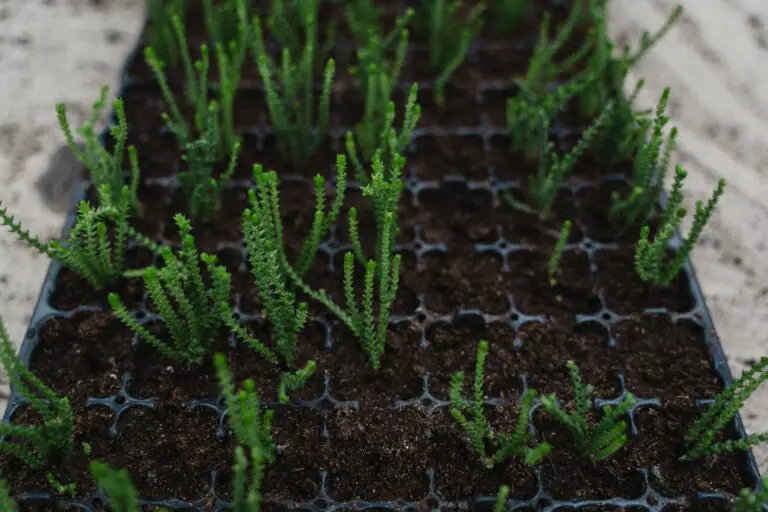
How Can I Tell Them Apart?
Let’s say you’re at your local nursery, and you find yourself in a ‘leafy’ situation, trying to pick between a Crassula and a Jade Plant. Here’s a tip—look at their leaves. The Jade Plant often flaunts its oval-shaped, heavy leaves that might remind you of jade coins (hence the name). On the other hand, your typical Crassula might have a more diverse wardrobe, with some species wearing thin, needle-like leaves that scream ‘I’m different!’
What’s the Big Deal About Their Care?
If you’re the proud parent of these green gems, remember—they’re both sun-worshippers but don’t want to get sunburnt. They prefer a cactus-like vacation spot: bright, indirect sunlight with some shade to cool off. Water them like you’re giving them a rare treat—sparingly and with love. Too much H2O and you might as well be sending them to the plant spa in the sky!
Is Propagation the Same for Both?
Ever wanted to play the role of a plant matchmaker? Propagating Crassula and Jade Plants might just be your calling. It’s like matchmaking in the plant world! Both can be propagated using leaves or stem cuttings, but patience is key. It’s like waiting for a pot of water to boil—a watched pot never boils, and a watched cutting never roots (or so it feels). Give them time, a little water, and before you know it, you’ll have a mini-me of your original plant.
How to Solve Common Problems?
Encountering a problem with your succulents can be a thorn in your side. If your Jade Plant or Crassula starts to drop leaves or look sadder than a wilting flower, it’s time to play detective. Check the basics first: are they getting the right light, water, and well-drained soil? Often, a simple adjustment to their care routine can turn their frowns upside down. And if pests have invited themselves to a feast on your plants, show them the door with some insecticidal soap or neem oil—no RSVP required!
Remember, whether you’re a budding botanist or a seasoned gardener, understanding your green friends is the root of a thriving plant relationship. So keep these tips in your gardening toolkit and watch your Crassula and Jade Plant thrive, making your green thumb even greener!
